| Maintenance Service Interval | Maintenance Procedure |
|---|---|
| Before each use or daily |
|
Introduction
This machine is intended to be used by residential homeowners. It is designed primarily for removing snow from paved surfaces, such as driveways and sidewalks, and other surfaces for traffic on residential or commercial properties. It is not designed for removing materials other than snow, nor is it designed for clearing gravel surfaces.
Read this information carefully to learn how to operate and maintain your product properly and to avoid injury and product damage. You are responsible for operating the product properly and safely.
You may contact Toro directly at www.Toro.com for product safety and operation training materials, accessory information, help finding a dealer, or to register your product.
Whenever you need service, genuine Toro parts, or additional information, contact an Authorized Service Dealer or Toro Customer Service and have the model and serial numbers of your product ready. Figure 1 identifies the location of the model and serial numbers on the product. Write the numbers in the space provided.
Important: With your mobile device, you can scan the QR code on the serial number decal (if equipped) to access warranty, parts, and other product information.
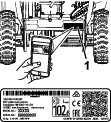
This manual identifies potential hazards and has safety messages identified by the safety-alert symbol (Figure 2), which signals a hazard that may cause serious injury or death if you do not follow the recommended precautions.

This manual uses 2 words to highlight information. Important calls attention to special mechanical information and Note emphasizes general information worthy of special attention.
Important: If you are using this machine above 1500 m (5,000 ft) for a continuous period, ensure that the High Altitude Kit has been installed so that the engine meets CARB/EPA emission regulations. The High Altitude Kit increases engine performance while preventing spark-plug fouling, hard starting, and increased emissions. Once you have installed the kit, attach the high-altitude label next to the serial decal on the machine. Contact any Authorized Toro Service Dealer to obtain the proper High Altitude Kit and high-altitude label for your machine. To locate a dealer convenient to you, access our website at www.Toro.com or contact our Toro Customer Care Department at the number(s) listed in your Emission Control Warranty Statement. Remove the kit from the engine and restore the engine to its original factory configuration when running the engine under 1500 m (5,000 ft). Do not operate an engine that has been converted for high-altitude use at lower altitudes; otherwise, you could overheat and damage the engine.If you are unsure whether or not your machine has been converted for high-altitude use, look for the following label (Figure 3).

Warning
CALIFORNIA
Proposition 65 Warning
The engine exhaust from this product contains chemicals known to the State of California to cause cancer, birth defects, or other reproductive harm.
Use of this product may cause exposure to chemicals known to the State of California to cause cancer, birth defects, or other reproductive harm.
Safety
This snowthrower is capable of injuring hands and feet and of throwing objects. Failure to observe the following safety instructions could result in serious injury.
This machine complies with ANSI/OPEI B71.3 specifications.
General Safety
-
Read and understand the contents of this Operator’s Manual before you start the engine. Ensure that everyone using this product knows how to use it, knows how to shut off the engine quickly, and understands the warnings.
-
Shut off the engine whenever you leave the operating position for any reason.
-
Do not put your hands or feet near moving parts on the machine.
-
Do not operate the machine without all guards and other safety protective devices in place and working.
-
Keep clear of any discharge opening. Keep bystanders, especially small children, out of the operating area.
-
Never allow children to operate the machine.
Safety and Instructional Decals
 |
Safety decals and instructions are easily visible to the operator and are located near any area of potential danger. Replace any decal that is damaged or missing. |


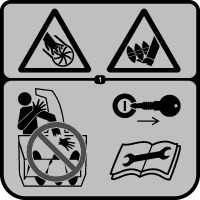

Setup
Unfolding the Handle

Installing the Discharge Chute

Installing the Chute-Control Rod

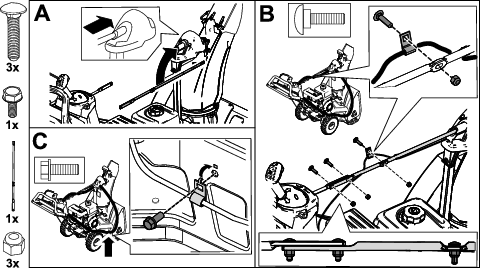
Checking the Engine-Oil Level
Note: Your machine comes with oil in the engine crankcase. Before starting the engine, check the oil level and add oil if necessary.
Refer to Checking the Engine-Oil Level.
Adjusting the Tire Pressure
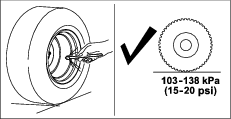
Product Overview
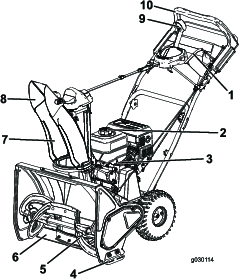
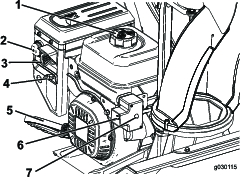
| Model | Weight | Length | Width | Height |
| 36002 | 56.7 kg | 132 cm | 65 cm | 108 cm |
| (125 lb) | ||||
| 36003 | 59.4 kg | (52 inches) | (25 inches) | (43 inches) |
| (131 lb) |
Attachments/Accessories
A selection of Toro approved attachments and accessories is available for use with the machine to enhance and expand its capabilities. Contact your Authorized Service Dealer or authorized Toro distributor or go to www.Toro.com for a list of all approved attachments and accessories.
To ensure optimum performance and continued safety certification of the machine, use only genuine Toro replacement parts and accessories. Replacement parts and accessories made by other manufacturers could be dangerous, and such use could void the product warranty.
Operation
Note: Determine the left and right sides of the machine from the normal operating position.
Before Operation
Before Operation Safety
General Safety
-
For electric-start models only: Use extension cords and receptacles as specified in the manual. Inspect the electrical cord before plugging it into a power source. If the cord is damaged, replace it. Unplug the power cord whenever you are not starting the machine.
-
Wear appropriate clothing, including eye protection; long pants; substantial, slip-resistant footwear; and hearing protection. Tie back long hair, secure loose clothing, and do not wear loose jewelry.
-
Thoroughly inspect the area where you will use the machine, and remove all doormats, sleds, boards, wires, and other foreign objects.
-
If a shield, safety device, or decal is damaged, illegible, or missing, repair or replace it before beginning operation. Also, tighten any loose fasteners.
-
Two-stage models only: Adjust the collector housing height to clear a gravel or crushed-rock surface.
Fuel Safety
Fuel is extremely flammable and explosive. A fire or explosion from fuel can burn you and others.
-
To prevent a static charge from igniting the fuel, place the container and/or machine on the ground before filling, not in a vehicle or on an object.
-
Fill the fuel tank outdoors when the engine is cold. Replace the fuel cap securely and wipe up spills.
-
Do not handle fuel when smoking or around an open flame or sparks.
-
Store fuel in an approved fuel container, out of the reach of children.
-
When fuel is in the tank, tip the machine only as directed in the instructions.
-
If you spill fuel on your clothing, change your clothing immediately.
Filling the Fuel Tank
-
For best results, use only clean, fresh (less than 30 days old), unleaded gasoline with an octane rating of 87 or higher ((R+M)/2 rating method).
-
Oxygenated fuel with up to 10% ethanol or 15% MTBE by volume is acceptable.
-
Do not use ethanol blends of gasoline (such as E15 or E85) with more than 10% ethanol by volume. Performance problems and/or engine damage may result which may not be covered under warranty.
-
Do not use gasoline containing methanol.
-
Do not store fuel either in the fuel tank or fuel containers over the winter unless you use a fuel stabilizer.
-
Do not add oil to gasoline.
Do not fill above the bottom of the fuel tank neck (Figure 10).

Important: For best results, purchase only the quantity of fuel that you expect to use in 30 days. Otherwise, you may use fuel stabilizer/conditioner in the machine at all times to keep the fuel fresh longer when used as directed by the fuel-stabilizer manufacturer.
Checking the Engine-Oil Level

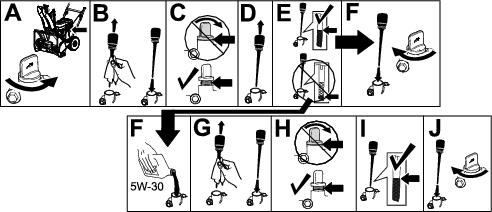
During Operation
During Operation Safety
General Safety
-
Shut off the engine before unclogging the machine and always use a stick or the snow-cleanout tool (if provided).
-
Stay behind the handles and away from the discharge opening while operating the machine. Keep your face, hands, feet, and any other part of your body or clothing away from moving or rotating parts.
-
Never direct the discharge toward people or areas where property damage can occur.
-
Use your full attention while operating the machine. Do not engage in any activity that causes distractions; otherwise, injury or property damage may occur.
-
Exercise caution to avoid slipping or falling, especially when operating the machine in reverse.
-
Always be sure of your footing, and keep a firm hold on the handles. Walk; never run.
-
Exercise extreme caution when operating the machine on a slope.
-
Do not operate the machine without good visibility or light.
-
Look behind and use care when backing up the machine.
-
When not actively clearing snow, disengage power to the auger.
-
Exercise extreme caution when operating the machine on or crossing gravel drives (2-stage models only), walks, or roads. Stay alert for hidden hazards or traffic.
-
Never attempt to make any adjustments while the engine is running, except as directed in the instructions.
-
After striking a foreign object, shut off the engine, remove the ignition key (electric-start models only), inspect the machine for damage. Repair any damage before starting the machine.
-
If the machine starts to vibrate abnormally, shut off the engine and check immediately for the cause.
-
Do not run the engine indoors; exhaust fumes are dangerous.
-
Do not overload the machine capacity by attempting to clear snow at too fast a rate.
-
Disengage all clutches and shift into neutral before starting the engine.
-
Shut off the engine whenever you leave the operating position, before clearing or unclogging the collector, impeller, or discharge chute, and when making any repairs, adjustments, or inspections.
-
Never operate the machine at high transport speeds on slippery surfaces.
Starting the Engine
Using the Electric Starter


Using the Recoil Starter


Engaging the Auger
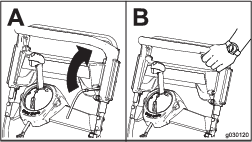
Disengaging the Auger
To disengage the auger, release the auger lever.
Self-Propelling the Machine
To operate the self-propel drive, simply walk with your hands on the upper handle and your elbows at your sides, and the machine automatically keeps pace with you (Figure 15).
Note: You can self-propel the machine with the auger engaged or disengaged.

Shutting Off the Engine
To shut off the engine, remove the key from the ignition or move the key to the middle position.
Operating the Quick Stick®
Note: Fully press the blue knob to release the latch and operate the Quick Stick®.
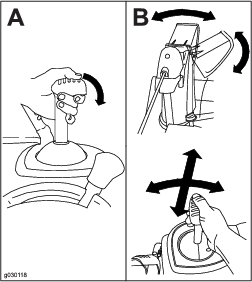
Clearing a Clogged Discharge Chute
Warning
If the auger/impeller is running but there is no snow coming out of the discharge chute, the discharge chute may be clogged.
Never use your hands to clear a clogged discharge chute. This could result in personal injury.
-
While remaining in the operating position, release the self-propel handle.
-
Engage the auger.
-
Push down on the handle to raise the front of the machine a few centimeters (inches) off the pavement, then lift the handles quickly to bump the front of the machine onto the pavement.
-
Disengage the auger.
-
Repeat steps 1 through 4, if necessary, until a stream of snow comes out of the discharge chute.
Important: If you cannot unclog the discharge chute by bumping the front of the machine, shut off the engine, wait for all moving parts to stop, and use a snow-cleanout tool (not included).
Important: Unclogging the discharge chute by bumping the front of the machine on the pavement may cause the skids to move. Adjust the skids and tighten the skid bolts securely; refer to Checking and Adjusting the Skids.
Operating Tips
Warning
The auger can throw stones, toys, and other foreign objects and cause serious personal injury to you or bystanders.
-
Keep the area to be cleared free of all objects that the rotor blades could pick up and throw.
-
Keep all children and pets away from the area of operation.
-
Remove the snow as soon as possible after it falls.
-
Overlap each swath to ensure complete snow removal.
-
Discharge the snow downwind whenever possible.
-
If the machine does not propel itself forward on slippery surfaces or in heavy snow, push forward on the handle, but allow the machine to work at its own pace.
After Operation
After Operation Safety
General Safety
-
Never store the machine with fuel in the fuel tank inside a building where ignition sources are present, such as hot water heaters, space heaters, or clothes dryers. Allow the engine to cool before storing the machine in any enclosure.
-
When storing the machine for more than 30 days, refer to Before storage for important information.
-
Run the machine a few minutes after throwing snow to prevent freeze-up of the collector and impeller.
Preventing Freeze-up after Use
-
Let the engine run for a few minutes to prevent moving parts from freezing. Shut off the engine, wait for all moving parts to stop, and remove ice and snow from the machine.
-
Clean off any snow and ice from the base of the chute. Always use a tool to clean snow out of a chute, never use your hand.
-
Rotate the discharge chute left and right to free it from any ice buildup.
-
With the ignition key in the OFF position, pull the recoil-start handle several times or connect the electrical cord to a power source and the machine and push the electric-start button once to prevent the recoil starter and/or the electric starter from freezing up (electric-start models only).
-
In snowy and cold conditions, some controls and moving parts may freeze. Do not use excessive force when trying to operate frozen controls. If you have difficulty operating any control or part, start the engine and let it run for a few minutes.
-
Do not use the chute control to attempt to move a frozen discharge chute. Hold down the blue knob and use your hands to rotate the chute.
-
Transporting the machine in an open trailer or vehicle can cause the controls or discharge chute to freeze.
Maintenance
Recommended Maintenance Schedule(s)
| Maintenance Service Interval | Maintenance Procedure |
|---|---|
| After the first hour |
|
| After the first 2 hours |
|
| Before each use or daily |
|
| Every 100 hours |
|
| Yearly |
|
| Yearly or before storage |
|
Maintenance Safety
Read the following safety precautions before performing any maintenance on the machine:
-
Before servicing, adjusting, or cleaning the machine, shut off the engine and remove the key. If major repairs are ever needed, contact an Authorized Service Dealer.
-
Always wear eye protection while performing an adjustment or repair to protect your eyes from foreign objects that the machine may throw.
-
Check all fasteners at frequent intervals for proper tightness to ensure that the machine is in safe working condition.
-
Do not change the governor settings on the engine.
Purchase only genuine Toro replacement parts and accessories.
Checking and Adjusting the Skids
| Maintenance Service Interval | Maintenance Procedure |
|---|---|
| Yearly |
|
Check the skids to ensure that the auger does not contact the paved surface. Adjust the skids as needed to compensate for wear (Figure 17).
-
Loosen the skid bolts.
-
Slide a 5 mm (3/16 inch) board underneath the scraper.
Note: Using a thinner board results in a more aggressive scraper; using a thicker board results in a less aggressive scraper.
-
Lower the skids to the ground.
Note: Ensure that the skids are flat on the ground.
-
Tighten the skid bolts.
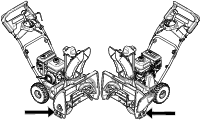
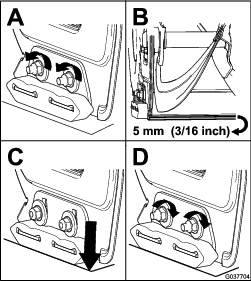
Inspecting the Throwing Edges
| Maintenance Service Interval | Maintenance Procedure |
|---|---|
| Yearly |
|
Before each session, inspect the throwing edges for wear. When a throwing edge has worn down to the wear-indicator hole, have an Authorized Service Dealer replace the throwing edges (Figure 18).

Changing the Engine Oil
| Maintenance Service Interval | Maintenance Procedure |
|---|---|
| After the first 2 hours |
|
| Yearly |
|

If possible, run the engine for a few minutes before changing the oil to warm it. Warm oil flows better and carries more contaminants.
| Engine oil capacity | Model 36002: 0.50 L (17 fl oz); Model 36003: 0.59 L (20 fl oz) |
| Oil viscosity | Refer to Figure 19. |
| API service classification | SJ or higher |
Use Figure 19 to select the best oil viscosity for the outdoor temperature range expected:
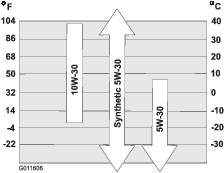
-
Move the machine to a level surface.
-
Place an oil-drain pan under the oil-drain plug, remove the oil-drain plug, and tip the machine backward and drain the used oil in the oil-drain pan (Figure 20).
Note: Dispose of the used oil properly at a local recycling center.
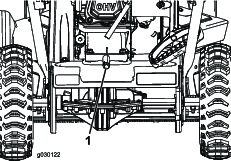
-
After draining the used oil, return the machine to the operating position.
-
Install the oil-drain plug and tighten it securely.
-
Clean around the oil-fill cap.
-
Fill the crankcase will oil.
Replacing the Spark Plug
| Maintenance Service Interval | Maintenance Procedure |
|---|---|
| Every 100 hours |
|
Warning
Replacing the spark plug while the engine is hot can result in burns.
Wait until the engine is cool to replace the spark plug.
Use a Toro spark plug or equivalent (Champion® RN9YC or NGK BPR6ES).
Adjusting the Auger Cable
| Maintenance Service Interval | Maintenance Procedure |
|---|---|
| After the first 2 hours |
|
| Yearly |
|
If the drive belt slips or squeals under a heavy load, adjust the auger cable.
-
Loosen the nut on the lower cable clamp, but do not remove it (Figure 23).
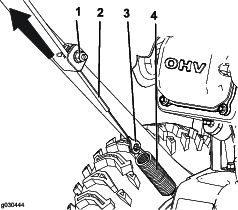
-
Pull the cable up to remove some slack (Figure 23).
Important: Do not remove all the slack from the cable. Removing all the slack from the cable prevents the auger from stopping properly.
-
Hold the cable in place and tighten the nut (Figure 23).
Adjusting the Transmission Cable
| Maintenance Service Interval | Maintenance Procedure |
|---|---|
| After the first 2 hours |
|
| Yearly |
|
If the wheels easily stall out, or if the wheels drive without engaging the self-propel handle, adjust the transmission cable.
-
Loosen the nut on the upper cable clamp, but do not remove it (Figure 24).

-
Pull the cable down to remove most of the slack in the cable (Figure 24).
Important: Do not remove all the slack from the cable. Removing all the slack from the cable may cause the wheels to engage without engaging the self-propel handle.
-
Tighten the nut (Figure 24).
Storage
Storing the Machine
Warning
Fuel fumes are highly flammable, explosive, and dangerous if inhaled. If you store the product in an area with an open flame, the fuel fumes may ignite and cause an explosion.
-
Do not store the machine in a house (living area), basement, or any other area where ignition sources may be present, such as hot water and space heaters, clothes dryers, furnaces, and other appliances.
-
Do not tip the machine either forward or backward with fuel in the fuel tank; otherwise, fuel may leak out of the machine.
-
Do not store the machine with its handle tipped down onto the ground; otherwise, oil leaks into the engine cylinder and onto the ground, and the engine does not start or run.
-
On the last refueling of the season, add fuel stabilizer to fresh fuel as directed by the fuel-stabilizer manufacturer.
Important: Do not store fuel longer than that suggested by the fuel-stabilizer manufacturer.
-
Run the engine for 10 minutes to distribute the conditioned fuel through the fuel system.
-
Shut off the engine, allow it to cool, and siphon the fuel tank or run the engine until it shuts off.
-
Start the engine and run it until it shuts off.
-
Choke or prime the engine, start it a third time, and run the engine until it does not start.
-
Drain the fuel in the carburetor through the carburetor-drain bolt into an approved gasoline container.
-
Dispose of unused fuel properly. Recycle it according to local codes, or use it in your automobile.
-
While the engine is still warm, change the engine oil. Refer to Changing the Engine Oil.
-
Remove the spark plug.
-
Squirt 10 ml (2 tsp) of oil into the spark-plug hole.
-
Install the spark plug by hand and then torque it to 27 to 30 N∙m (20 to 22 ft-lb).
-
With the ignition key removed, pull the recoil-start handle slowly to distribute the oil on the inside of the cylinder.
-
Clean the machine.
-
Touch up chipped surfaces with paint available from an Authorized Service Dealer. Sand affected areas before painting, and use a rust preventative to prevent the metal parts from rusting.
-
Tighten any loose fasteners. Repair or replace any damaged parts.
-
Cover the machine and store it in a clean, dry place out of the reach of children. Allow the engine to cool before storing the machine in any enclosure.

